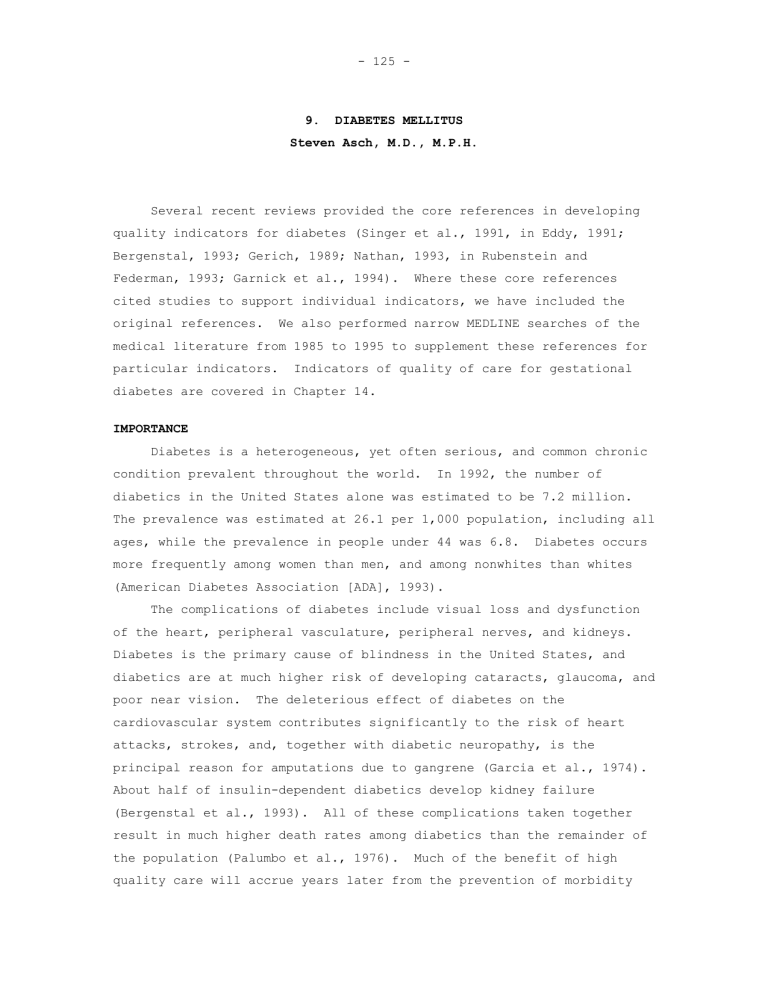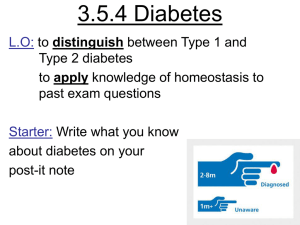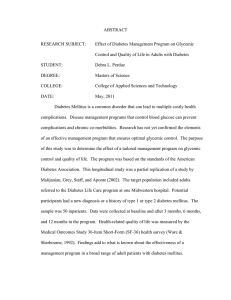- 125 - 9. DIABETES MELLITUS

- 125 -
9. DIABETES MELLITUS
Steven Asch, M.D., M.P.H.
Several recent reviews provided the core references in developing quality indicators for diabetes (Singer et al., 1991, in Eddy, 1991;
Bergenstal, 1993; Gerich, 1989; Nathan, 1993, in Rubenstein and
Federman, 1993; Garnick et al., 1994). Where these core references cited studies to support individual indicators, we have included the original references. We also performed narrow MEDLINE searches of the medical literature from 1985 to 1995 to supplement these references for particular indicators. Indicators of quality of care for gestational diabetes are covered in Chapter 14.
IMPORTANCE
Diabetes is a heterogeneous, yet often serious, and common chronic condition prevalent throughout the world. In 1992, the number of diabetics in the United States alone was estimated to be 7.2 million.
The prevalence was estimated at 26.1 per 1,000 population, including all ages, while the prevalence in people under 44 was 6.8. Diabetes occurs more frequently among women than men, and among nonwhites than whites
(American Diabetes Association [ADA], 1993).
The complications of diabetes include visual loss and dysfunction of the heart, peripheral vasculature, peripheral nerves, and kidneys.
Diabetes is the primary cause of blindness in the United States, and diabetics are at much higher risk of developing cataracts, glaucoma, and poor near vision. The deleterious effect of diabetes on the cardiovascular system contributes significantly to the risk of heart attacks, strokes, and, together with diabetic neuropathy, is the principal reason for amputations due to gangrene (Garcia et al., 1974).
About half of insulin-dependent diabetics develop kidney failure
(Bergenstal et al., 1993). All of these complications taken together result in much higher death rates among diabetics than the remainder of the population (Palumbo et al., 1976). Much of the benefit of high quality care will accrue years later from the prevention of morbidity
- 126 and mortality from such complications. Death rates from diabetes itself increase with age ranging from 0.2 per 100,000 for those between 15 and
19 years of age to 14.6 per 100,000 for those between 50 and 54 years; older patients experience even higher rates (National Center for Health
Statistics [NCHS], 1994a).
The treatment of diabetes is resource intensive, with total costs estimated at $30-40 billion annually in 1992 (ADA, 1993), or one of every seven dollars spent on health care in 1992 (Rubin et al., 1994).
Diabetes was the eighth most common reason for a patient visiting a physician’s office in 1992 (NCHS, 1994b).
EFFICACY AND/OR EFFECTIVENESS OF INTERVENTIONS
Screening
Indicators of the quality of screening diabetics for complications of diabetes are covered under diagnosis below. This section covers screening patients not known to be diabetic for the disease. Both the
American College of Physicians (ACP) (Singer et al., 1991, in Eddy,
1991) and the Canadian Task Force (CTF) on the Periodic Health
Examination (1979) recommended that asymptomatic patients need not undergo screening for diabetes. These recommendations were based on the poor evidence that treatment of patients so identified would prevent complications. Though many persons have asymptomatic hyperglycemia, most complications of diabetes occur late in the course of the disease, limiting the benefits of early identification. Since the publication of those recommendations, the Diabetes Control and Complication Trial
(DCCT) (see below) has added evidence for the efficacy of tight control in known diabetics in preventing complications (DCCT, 1993a). However, we have found no subsequent studies directly evaluating the efficacy of screening asymptomatic patients in reducing morbidity or mortality from diabetes (Singer, 1988; CTF, 1979).
Diagnosis
The initial diagnosis of diabetes depends upon the measurement of a fasting blood sugar greater than 140/mg/dl or a postprandial blood sugar of greater than 200/mg/dl. If a recorded blood sugar meets the above
- 127 criteria, we recommend looking for notation of the diagnosis of diabetes in the progress notes or problem list. Most experts also recommend a complete history and physical examination, dietary evaluation, urinalysis for protein, measurement of blood creatinine, and a lipid panel at the time of initial diagnosis (ADA, 1989). We do not propose any of these as quality indicators for the initial diagnosis because of the small number of incident cases in our sample and the difficulty of defining the time of initial diagnosis.
We instead concentrate on the routine diagnostic tests that known diabetics should undergo regardless of their clinical status and stage of disease. The first of these is the measurement of glycosylated hemoglobin to monitor glycemic control. A randomized controlled trial of 240 patients found that measuring hemoglobin A
1c
every three months led to changes in diabetic treatment and improvement in metabolic control, indicated by a lowering of average hemoglobin A
1c
values
(Larsen et al., 1990). The landmark DCCT followed 1,441 insulindependent diabetics for 9 years and found that tight glycemic control and lower hemoglobin A
1c
values decreased rates of diabetic complications (DCCT, 1993a). Despite recommendations from a number of specialty and generalist physician societies, there is great variation in the use of this test (ADA, 1993; Bergenstal et al., 1993; Garnick et al., 1994; Goldstein et al., 1994). We propose as a quality indicator a hemoglobin A
1c
test be done for all diabetics at six-month intervals, the longest recommended interval.
Home blood glucose monitoring has been shown to aid glycemic control in diabetics treated with insulin. The DCCT employed home blood glucose monitoring for its population of insulin-dependent diabetics, rather than the more easily tolerated urine glucose monitoring to achieve tight control, because moderate hyperglycemia (180 mg/dl) may not cause glycosuria. At least one small randomized trial (n=23) has shown home blood glucose monitoring to improve glycemic control in obese insulin-dependent diabetics (Allen et al., 1990). The optimal frequency of monitoring has not yet been determined, though some studies have questioned patients’ ability to comply with frequent measurement
(Bergenstal et al., 1993; Health and Public Policy Committee, 1983;
- 128 -
Muchmore et al., 1994; Gordon, 1991). Observational data have failed to find any strong relationship between home blood glucose monitoring and glycemic control in noninsulin-dependent diabetics (Patrick, 1994; Allen et al., 1990). Specialty societies recommend that patients on insulin be offered training and equipment for home glucose monitoring, and we propose this as another indicator of diagnostic quality (ADA, 1993).
For patients not taking insulin, randomized trials have not shown home blood glucose to be any more effective at maintaining glycemic control than urine testing (Allen et al., 1990).
Because of the frequency of vision, cardiovascular, and renal complications among diabetics, many of which may be asymptomatic, the
ADA (1989) has recommended several screening tests on an annual basis: eye exam, tests of triglycerides, total cholesterol, HDL cholesterol, urinalysis, and total urinary protein excretion. An annual eye and vision exam conducted by an ophthalmologist, beginning five years after diagnosis, has also been recommended by the ACP, the ADA, and the
American Academy of Ophthalmology (AAO) (ACP, ADA and AAO, 1992).
Retinal examination by generalists has been shown to be much less effective in detecting retinopathy at an early treatable stage (Reenders et al., 1992). The routine evaluation of the other screening recommendations has never been tested in controlled trials, but the conditions screened for (hyperlipidemia, nephropathy, and ESRD) are both more common in diabetics and amenable to intervention (The Carter
Center, 1985). Compliance with ADA screening recommendations has been estimated to vary from 20 to 50 percent (Garnick et al., 1994; Brechner et al., 1993).
Other common treatable complications of diabetes include hypertension, cellulitis, and osteomyelitis. The ADA recommends blood pressure measurement and examination of the feet at every visit to detect these complications early in their course as well as a careful history to elicit signs and symptoms of hypoglycemia and hyperglycemia.
No controlled trials have examined the efficacy of a regular history and physical examination.
- 129 -
Treatment
Recent debate in the area of diabetic treatment hinges on the utility of tight glycemic control. The goal of tight control and prevention of long-term complications through aggressive treatment is supported by the DCCT (DCCT, 1993a). The DCCT randomized 1,441 insulindependent diabetics into conventional therapy or intensive therapy that included daily adjustments of insulin dosage, frequent home glucose monitoring, and nutritional advice. Under the optimal circumstances present in the DCCT trial, 44 percent of the intervention group achieved glycosolated hemoglobin values under the goal of 6.05 mg/dl percent at least once, but only 5 percent maintained average values in that range.
The intervention group developed 76 percent less retinopathy, 57 percent less albuminuria, and 60 percent less clinical neuropathy, but this reduction in diabetic complications may come at the expense of quality of life (Nerenz et al., 1992). For example, the tight control group in
DCCT experienced a two- to three-fold increase in hypoglycemic episodes.
The efficiency of such methods in general practice has not received adequate evaluation. Nonetheless, the ADA recommends that all diabetics over the age of seven be offered similar aggressive therapy.
Treatment strategies are different for Type I diabetes (complete pancreatic deficiency of insulin) and Type II diabetes (abnormal secretion of insulin and resistance to insulin action). In Type I diabetes, emphasis is placed on avoidance of diabetic ketoacidosis and tight control of blood sugar levels through the judicious use of insulin. In Type II diabetes, the focus shifts to control of symptoms, usually with a combination of diet, exercise, and oral hypoglycemic agents. If these measures fail to maintain adequate control in Type II diabetics, then insulin therapy is warranted. We will review the evidence for quality indicators for each of these treatment modalities in turn.
Adherence to the ADA-recommended diet decreases insulin and oral hypoglycemic requirements and serum lipids (Bantle, 1988). The DCCT trial relied on dieticians and revealed that greater adherence to dietary instructions resulted in better control (DCCT, 1993b). Exercise improves glucose tolerance and may reduce or eliminate the need for drug
- 130 therapy (Raz et al., 1994). The ADA and the American Board of Family
Practice recommend dietary and exercise counseling at both the initial diagnosis and before starting oral hypoglycemics or insulin (ADA, 1989;
Bergenstal et al., 1993). We recommend evaluating the medical record for evidence that all diabetics have received dietary and exercise counseling and that Type II diabetics have undergone a trial of this conservative therapy prior to pharmaceutical intervention.
Randomized controlled trials have shown oral hypoglycemic agents to effectively improve glycemic control and prevent hyperglycemic coma.
Although the effectiveness of these agents in preventing longer-term complications of Type II diabetes has been questioned, particularly in the controversial UGDP Trial of the 1970’s (Gerich, 1989; Kilo et al.,
1980; Knatterud, 1978), we recommend evaluating the medical record to determine if oral hypoglycemic therapy has been offered to symptomatic
Type II diabetics who have already received a trial of dietary therapy.
Insulin treatment is essential for Type I diabetics and a treatment of last resort for Type II diabetics. The literature contains varied recommendations as to the optimal timing and content of insulin injections (Gregerman, 1991, in Barker et al., 1991; Knatterud, 1978), and no single regimen has emerged as superior. However, the ADA recommends that all diabetics taking insulin receive formal instruction in the technique of injection (ADA, 1989; Bergenstal et al., 1993). We recommend evaluating the medical record for evidence that this has taken place. We also recommend that symptomatic Type II diabetics who have failed oral hypoglycemics be offered insulin.
Though quality indicators for treatment of hypertension are covered elsewhere (Chapter 12), the intersection of diabetes and hypertension poses special treatment challenges. Control of hypertension is perhaps the most crucial step in preventing diabetic nephropathy. In particular, ACE inhibitors and possibly calcium channel blockers have been shown to reduce hyperalbuminuria and delay the progression to diabetic nephropathy (Lederle, 1992; Anderson, 1990). Beta blockers on the other hand may block the symptoms of hypoglycemia, and thus may be contraindicated in treated diabetics (Hamilton, 1990). We propose that diabetics with hypertension receive ACE inhibitors or calcium channel
- 131 blockers as first-line pharmacotherapy if diet has failed to control blood pressure.
Follow-up
A study of internists and family practitioners using patient vignettes found wide variation in recommended follow-up intervals for diabetics (Petitti and Grumbach, 1993). The ADA (1989) guidelines recommend that regular visits be scheduled every three months for insulin-dependent diabetics and every six months for other diabetics.
As a minimum standard of care for patients with diabetes, we suggest a visit every six months.
RECOMMENDED QUALITY INDICATORS FOR DIABETES MELLITUS
The following criteria apply to nonpregnant women age 18-50.
Diagnosis
Indicator
1.
Patients with fasting blood sugar >140 or postprandial blood sugar >200 should have diabetes noted in progress notes or problem list.
2.
Patients with the diagnosis of diabetes should have glycosylated hemoglobin every 6 months.
Quality of evidence
III
Literature
ADA, 1989
I, III
3.
Patients with the diagnosis of diabetes should have each of the following at least once a year: a. Eye and visual exam; b. Triglycerides; c. Total cholesterol; d. HDL cholesterol; and e. Urinalysis.
I, III
Benefits
Prevent diabetic complications.*
ADA, 1989;
Larsen et al.,
1990; ACP,
ADA and AAO,
1992
ADA, 1989;
Larsen et al.,
1990; ACP,
ADA and AAO,
1992
Prevent diabetic complications.*
Prevent diabetic complications.*
Prevent retinopathy, hyperlipidemia, atherosclorotic complications, and renal disease.
4.
Patients with the diagnosis of diabetes should have each of the following at every visit: f. examination of feet; and g. measurement of blood pressure.
5.
Patients taking insulin should monitor their glucose at home.
I, III
III
ADA, 1989;
Larsen et al.,
1990; ACP,
ADA and AAO,
1992
ADA, 1993
Prevent diabetic complications.*
Prevent lower renal disease, extremity amputation, reduced morbidity from foot infections.
Prevent hypoglycemic episodes.
Prevent diabetic complications.*
Comments
This definition of diabetes is accepted worldwide. Blood sugar tests are often ordered as part of panels; this indicator will test the timeliness of follow-up on an abnormal result.
Randomized controlled trial of 240 patients indicated a significant decrease in hemoglobin A
1c
among those whose hemoglobin A
1c
was monitored. Time interval is that used in most clinical trials.
Eye and visual exam shown to detect retinopathy at an earlier treatable stage.
Other recommendations based on expert opinion, though studies have shown conditions they screen for to be more common in diabetics and all are susceptible to treatment with improved outcomes resulting from earlier detection.
These are ADA recommendations. Earlier detection of treatable disease reduces probability of developing serious complications. Exam provides an opportunity for patient education.
A small RCT found that home glucose monitoring increases glycemic control in insulin dependent diabetics. Another study found no difference in control by frequency of monitoring. Recommended by the ADA.
132
Treatment
Indicator
6.
7.
8.
Diabetics should receive dietary and exercise counseling.
Type II diabetics who have failed dietary therapy should receive oral hypoglycemic therapy.
Type II diabetics who have failed oral hypoglycemics should be offered insulin.
9.
If patient is receiving other antihypertensive therapy in the absence of ACE inhibitors or calcium channel blockers, progress note should document failure of ACE inhibitors and calcium channel blockers to control blood pressure.
Quality of evidence
II
III
III
I
Literature
Raz et al.,
1994;
Delahanty and
Halford, 1993;
ADA, 1989;
Bergenstal et al., 1993
ADA, 1989;
Gerich, 1989;
Bergenstal et al., 1993
Benefits
Reduce diabetic complications.*
Reduce diabetic complications.*
Comments
Adherence to ADA diet decreases insulin and oral hypoglycemic requirements and serum lipids. Exercise improves glucose tolerance and may reduce or eliminate need for drug therapy. DCCT used dieticians and found that adherence to diet improved control and the ADA and the ABFP recommend their use. No study has found that dietary counseling reduces diabetic complications.
Observational trials have shown oral hypoglycemics to be effective in treating hyperglycemia and improving glycemic control. No studies have shown reduction of diabetic complications. Specialty societies and review articles widely recommend their use in mild to moderate disease before starting insulin.
Recommended by the ADA and ABFP.
ADA, 1989;
Bergenstal et al., 1993
Lederle, 1992;
Anderson,
1990
Reduce diabetic complications.*
Reduce rate of renal failure.
Randomized controlled trials have demonstrated a reduction in albuminuria and progression of diabetic nephropathy in hypertensive patients treated with ACE inhibitors and possibly calcium channel blockers.
133
Follow-up
Indicator
10.
Patients with diabetes should have a follow-up visit at least every 6 months.
Quality of evidence
III
Literature Benefits
Bergenstal et al., 1993; ADA,
1989
Reduce probability of severe diabetic complications.*
*Diabetic complications include visual loss and dysfunction of the heart, peripheral vasculature, peripheral nerves, and kidneys.
Comments
Visits for diabetic patients in control should be every 3-6 months (per ABFP).
Routine monitoring facilitates early detection and treatment of complications.
Quality of Evidence Codes:
I:
II-1:
II-2:
II-3:
III:
RCT
Nonrandomized controlled trials
Cohort or case analysis
Multiple time series
Opinions or descriptive studies
134
- 135 -
REFERENCES - DIABETES
Allen BT, ER DeLong, and JR Feussner. October 1990. Impact of glucose self-monitoring on non-insulin-treated patients with type II diabetes mellitus: Randomized controlled trial comparing blood and urine testing. Diabetes Care 13 (10): 1044-50.
American College of Physicians, American Diabetes Association, and
American Academy of Ophthalmology. 15 April 1992. Screening guidelines for diabetic retinopathy. Annals of Internal Medicine 116
(8): 683-5.
American Diabetes Association. 1993. Direct and Indirect Costs of
Diabetes in the United States in 1992.Alexandria, VA: American
Diabetes Association.
American Diabetes Association. May 1989. Standards of medical care for patients with diabetes mellitus. Diabetes Care 12 (5): 365-8.
Anderson S. 1990. Renal effects of converting enzyme inhibitors in hypertension and diabetes. Journal of Cardiovascular Pharmacology 15
(Suppl. 3): S11-S15.
Bantle JP. 1988. The dietary treatment of diabetes mellitus. Medical
Clinics of North America 72 (6): 1285-99.
Bergenstal RM, WE Hall, and JA Haugen. 1993. Diabetes Mellitus:
Reference Guide, Fourth ed.Lexington, KY: American Board of Family
Practice.
Brechner RJ, CC Cowie, LJ Howie, et al. 13 October 1993. Ophthalmic examination among adults with diagnosed diabetes mellitus. Journal
of the American Medical Association 270 (14): 1714-7.
Canadian Task Force on the Periodic Health Examination. 3 November 1979.
The periodic health examination. Canadian Medical Association
Journal 121: 1193-1254.
The Carter Center. July 1985. Closing the gap: The problem of diabetes mellitus in the United States. Diabetes Care 8 (4): 391-406.
Delahanty LM, and BN Halford. November 1993. The role of diet behaviors in achieving improved glycemic control in intensively treated patients in the Diabetes Control and Complications Trial. Diabetes
Care 16 (11): 1453-8.
The Diabetes Control and Complications Trial Research Group. 30
September 1993. The effect of intensive treatment of diabetes on the development and progression of long-term complications in insulin-
- 136 dependent diabetes mellitus. New England Journal of Medicine 329
(14): 977-86.
The Diabetes Control and Complications Trial Research Group. July 1993.
Expanded role of the dietitian in the Diabetes Control and
Complications Trial: Implications for clinical practice. Journal of
the American Dietetic Association 93 (7): 758-67.
Garcia MJ, PM McNamara, T Gordon, et al. February 1974. Morbidity and mortality in diabetics in the Framingham population: Sixteen-year follow-up study. Diabetes 23 (2): 105-11.
Garnick DW, J Fowles, AG Lawthers, et al. 18 February 1994. Focus on quality: Profiling physicians' practice patterns. In Press, Journal
Ambulatory Care Management.
Gerich JE. 2 November 1989. Oral hypoglycemic agents. New England
Journal of Medicine 321 (18): 1231-45.
Golden MP, and DL Gray. 1992. Diabetes Mellitus. In Textbook of
Adolescent Medicine. McAnarney ER, RE Kriepe, DP Orr, et al.,Philadelphia, PA: W. B. Saunders Company.
Goldstein DE, RR Little, H Wiedmeyer, et al. 1994. Is glycohemoglobin testing useful in diabetes mellitus? Lessons from the Diabetes
Control and Complications Trial. Clinical Chemistry 40 (8): 1637-40.
Gordon D, CG Semple, and KR Paterson. 1991. Do different frequencies of self-monitoring of blood glucose influence control in type 1 diabetic patients. Diabetic Medicine 8: 679-82.
Gregerman RI. 1991. Diabetes mellitus. In Principles of Ambulatory
Medicine, Third ed. Editors Barker LR, JR Burton, and PD Zieve, 913-
51. Baltimore, MD: Williams and Wilkins.
Hamilton BP. October 1990. Diabetes mellitus and hypertension. American
Journal of Kidney Diseases 16 (4-Suppl.1): 20-9.
Health and Public Policy Committee, and American College of Physicians.
August 1983. Selected methods for the management of diabetes mellitus. Annals of Internal Medicine 99 (2): 272-4.
Kilo C, JP Miller, and JR Williamson. 1 February 1980. The Achilles heel of the University Group Diabetes Program. Journal of the American
Medical Association 243 (5): 450-7.
Knatterud GL, CR Klimt, ME Levin, et al. 7 July 1978. Effects of hypoglycemic agents on vascular complications in patients with adult-onset diabetes. Journal of the American Medical Association
240 (1): 37-42.
- 137 -
Larsen ML, M Horder, and EF Mogensen. 11 October 1990. Effect of longterm monitoring of glycosylated hemoglobin levels in insulindependent diabetes mellitus. New England Journal of Medicine 323
(15): 1021-5.
Lederle RM. 1992. The effect of antihypertensive therapy on the course of renal failure. Journal of Cardiovascular Pharmacology 20 (Suppl.
6): S69-S72.
Muchmore DB, J Springer, and M Miller. 1994. Self-monitoring of blood glucose in overweight type 2 diabetic patients. Acta Diabetologica
31: 215-9.
Nathan DM. 1993. Diabetes mellitus. In Scientific American Medicine.
Editor Rubenstein E, and D Federman,New York, NY: Scientific
American Illustrated Library.
National Center for Health Statistics. 18 August 1994. National
Ambulatory Medical Care Survey: 1992 summary. U.S. Department of
Health and Human Services, Hyattsville, MD.
National Center for Health Statistics. 1994. Vital statistics of the
United States, 1990, vol. II: Mortality-part A. U.S. Department of
Health and Human Services, Hyattsville, MD.
Nerenz DR, DP Repasky, FW Whitehouse, et al. May 1992. Ongoing assessment of health status in patients with diabetes mellitus.
Medical Care Supplement 30 (5, Supplement): MS112-MS123.
Palumbo PJ, LR Elveback, C Chu, et al. July 1976. Diabetes mellitus:
Incidence, prevalence, survivorship, and causes of death in
Rochester, Minnesota 1945-1970. Diabetes 25 (7): 566-73.
Patrick AW, GV Gill, IA MacFarlane, et al. 1994. Home glucose monitoring in type 2 diabetes: Is it a waste of time? Diabetic Medicine 11:
62-5.
Petitti DB, and K Grumbach. September 1993. Variation in physicians' recommendations about revisit interval for three common conditions.
Journal of Family Practice 37 (3): 235-40.
Raz I, E Hauser, and M Bursztyn. 10 October 1994. Moderate exercise improves glucose metabolism in uncontrolled elderly patients with non-insulin-dependent diabetes mellitus. Israel Journal of Medical
Sciences 30 (10): 766-70.
Reenders K, E De Nobel, H Van Den Hoogen, et al. 1992. Screening for diabetic retinopathy by general practitioners. Scandinavian Journal
of Primary Health Care 10: 306-9.
- 138 -
Rubin RJ, WM Altman, and DN Mendelson. 1994. Health care expenditures for people with diabetes mellitus, 1992. Journal of Clinical
Endocrinology and Metabolism 78 (4): 809A-F.
Singer DE, JH Samet, CM Coley, et al. 15 October 1988. Screening for diabetes mellitus. Annals of Internal Medicine 109: 639-49.
Singer DE, JH Samet, CM Coley, et al. 1991. Screening for diabetes mellitus. In Common Screening Tests. Editor Eddy DM, 154-78.
Philadelphia, PA: American College of Physicians.




